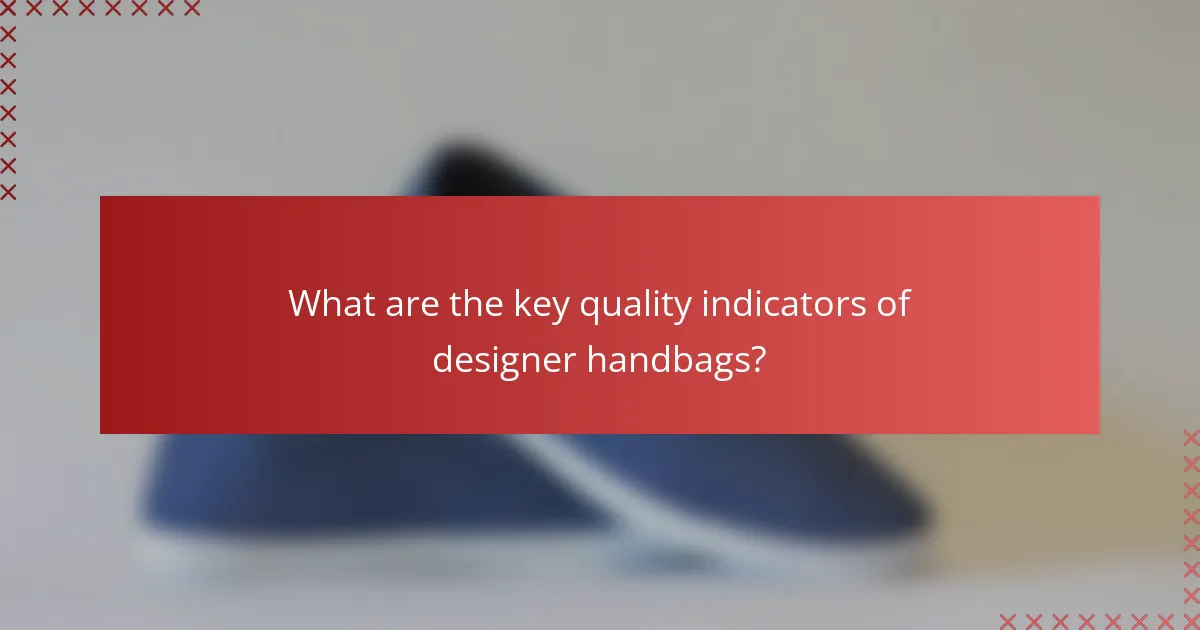When investing in a designer handbag, it’s essential to consider factors that contribute to its longevity, such as material quality, brand reputation, and construction techniques. High-quality craftsmanship and attention to detail are key indicators of a handbag’s durability and overall value. Renowned brands like Chanel, Hermès, Louis Vuitton, and Gucci exemplify these qualities, ensuring their handbags remain stylish and resilient over time.

How to choose a durable designer handbag?
To choose a durable designer handbag, focus on material quality, brand reputation, construction techniques, care instructions, and warranty options. These factors significantly influence the longevity and overall value of the handbag.
Material quality
The material of a handbag is crucial for its durability. High-quality leather, such as full-grain or top-grain, is often more resilient than lower grades. Additionally, synthetic materials like nylon or canvas can also offer excellent durability when crafted properly.
Check for features like water resistance and scratch resistance, which can enhance the lifespan of the handbag. Look for bags made from materials that are easy to clean and maintain, as this will help preserve their appearance over time.
Brand reputation
Brand reputation plays a significant role in determining the durability of a designer handbag. Established brands often have a history of quality craftsmanship and customer satisfaction. Research customer reviews and ratings to gauge the reliability of a brand.
Consider brands that offer a good balance between luxury and durability. Some brands are known for their commitment to using high-quality materials and ethical production practices, which can be indicative of a longer-lasting product.
Construction techniques
Construction techniques are vital for the durability of a handbag. Look for bags with reinforced stitching, as this can prevent seams from splitting over time. Handcrafted bags often exhibit superior craftsmanship compared to mass-produced options.
Pay attention to details such as the quality of zippers, hardware, and linings. High-quality zippers and sturdy hardware can withstand daily use, while a well-finished lining can protect the interior of the bag from wear and tear.
Care instructions
Proper care is essential for maintaining the durability of a designer handbag. Always follow the manufacturer’s care instructions, which may include cleaning methods and storage tips. For leather bags, regular conditioning can prevent cracking and drying.
Avoid exposing your handbag to extreme temperatures or direct sunlight for prolonged periods, as this can damage the material. Using protective sprays can also help shield the bag from stains and moisture.
Warranty options
Warranty options can provide peace of mind when investing in a designer handbag. Many reputable brands offer warranties that cover defects in materials and workmanship. Review the warranty terms carefully to understand what is included and for how long.
Some brands may offer extended warranties or repair services, which can be beneficial if your handbag requires maintenance over time. Always keep your purchase receipt, as it may be necessary for warranty claims.

What are the key quality indicators of designer handbags?
The key quality indicators of designer handbags include craftsmanship, material selection, and attention to detail. These factors significantly influence the longevity and overall value of the handbag, ensuring that it withstands the test of time both in style and durability.
Stitching details
Stitching is a critical quality indicator in designer handbags. High-quality handbags typically feature tight, even stitches that are consistent throughout the product. Look for double-stitching or reinforced seams, which enhance durability and prevent unraveling.
Examine the stitching closely; any loose threads or uneven patterns can indicate poor craftsmanship. A well-stitched handbag not only looks better but also signifies a higher level of attention to detail from the designer.
Hardware quality
The quality of hardware, such as zippers, clasps, and buckles, is essential for the functionality and aesthetic of designer handbags. Premium handbags often use solid metals or high-grade materials that resist tarnishing and wear. Check for smooth operation and sturdy construction in these components.
Additionally, the finish of the hardware should be flawless, with no scratches or discoloration. Investing in handbags with high-quality hardware can prevent frequent replacements and enhance the overall longevity of the accessory.
Interior lining materials
The interior lining of a handbag plays a vital role in its quality and usability. Designer handbags often use luxurious materials like silk, suede, or high-quality cotton, which not only provide a sophisticated look but also enhance durability. A well-lined interior can protect the contents and maintain the handbag’s shape over time.
When evaluating a handbag, consider the practicality of the lining as well. Features like pockets, compartments, and easy-to-clean materials can significantly improve the user experience. Avoid handbags with flimsy or poorly sewn linings, as they can lead to wear and tear more quickly.

Which designer handbag brands are known for longevity?
Designer handbag brands recognized for their longevity typically combine high-quality materials, expert craftsmanship, and timeless designs. Brands like Chanel, Hermès, Louis Vuitton, and Gucci have established reputations for creating durable handbags that retain their value over time.
Chanel
Chanel handbags, particularly the Classic Flap and Boy Bag, are synonymous with luxury and longevity. Crafted from premium leather and featuring meticulous stitching, these bags often last for decades when properly cared for. Their iconic status also means they often appreciate in value, making them a wise investment.
When purchasing a Chanel bag, consider the condition and authenticity, as counterfeits are prevalent. Buying from reputable retailers or directly from Chanel can help ensure you receive a genuine product.
Hermès
Hermès is renowned for its Birkin and Kelly bags, which are crafted from the finest leathers and materials. The production process is labor-intensive, often taking several days to complete a single bag, which contributes to their exceptional durability. These bags are not only functional but also highly sought after, often selling for significantly more than their original retail price.
To maintain the longevity of an Hermès bag, avoid exposure to harsh elements and store it in its dust bag when not in use. Regular cleaning and conditioning can also help preserve the leather’s appearance.
Louis Vuitton
Louis Vuitton handbags, especially those made with the iconic Monogram canvas, are known for their resilience and timeless appeal. The canvas is water-resistant and easy to clean, while the leather trim adds a touch of luxury. Popular models like the Speedy and Neverfull are designed for everyday use and can withstand wear and tear.
When investing in a Louis Vuitton bag, look for pieces with solid stitching and minimal signs of wear. Authenticity is crucial, so purchasing from authorized retailers or the brand’s official website is recommended.
Gucci
Gucci handbags, such as the GG Marmont and Dionysus, are celebrated for their stylish designs and quality materials. The brand uses high-grade leather and innovative fabrics, ensuring that their bags are both fashionable and durable. Gucci’s commitment to craftsmanship means that these bags can last for many years with proper care.
To ensure the longevity of a Gucci bag, avoid overloading it and clean it regularly with appropriate leather care products. Keeping the bag in its dust bag when not in use can also help protect it from dust and scratches.

How does handbag care affect longevity?
Handbag care significantly impacts its longevity by preventing wear and tear, maintaining appearance, and preserving material integrity. Proper maintenance practices can extend the lifespan of a handbag, ensuring it remains a valuable accessory for years.
Regular cleaning
Regular cleaning is essential for maintaining the appearance and durability of a handbag. Dust, dirt, and oils can accumulate, leading to stains and degradation of materials. Aim to clean your handbag every few weeks, using a soft cloth and appropriate cleaners for the specific material.
For leather bags, consider using a damp cloth followed by a dry one to remove moisture. For fabric handbags, a gentle brush can help lift dirt without damaging the fibers. Avoid harsh chemicals that can strip color or damage the material.
Proper storage
Proper storage is crucial for preserving the shape and condition of a handbag. Store bags in a cool, dry place away from direct sunlight to prevent fading and cracking. Use dust bags or pillow inserts to maintain their shape and avoid creasing.
When stacking handbags, place heavier bags at the bottom to prevent crushing lighter ones. If possible, hang larger bags on hooks to keep them off surfaces and maintain their structure.
Conditioning leather
Conditioning leather handbags helps maintain their suppleness and prevents cracking. Use a high-quality leather conditioner every 3-6 months, depending on usage and climate conditions. This practice nourishes the leather, keeping it hydrated and extending its lifespan.
Before applying conditioner, ensure the handbag is clean and dry. Test the conditioner on a small, inconspicuous area first to check for any adverse reactions. Avoid over-conditioning, as this can lead to a greasy appearance and attract dirt.
